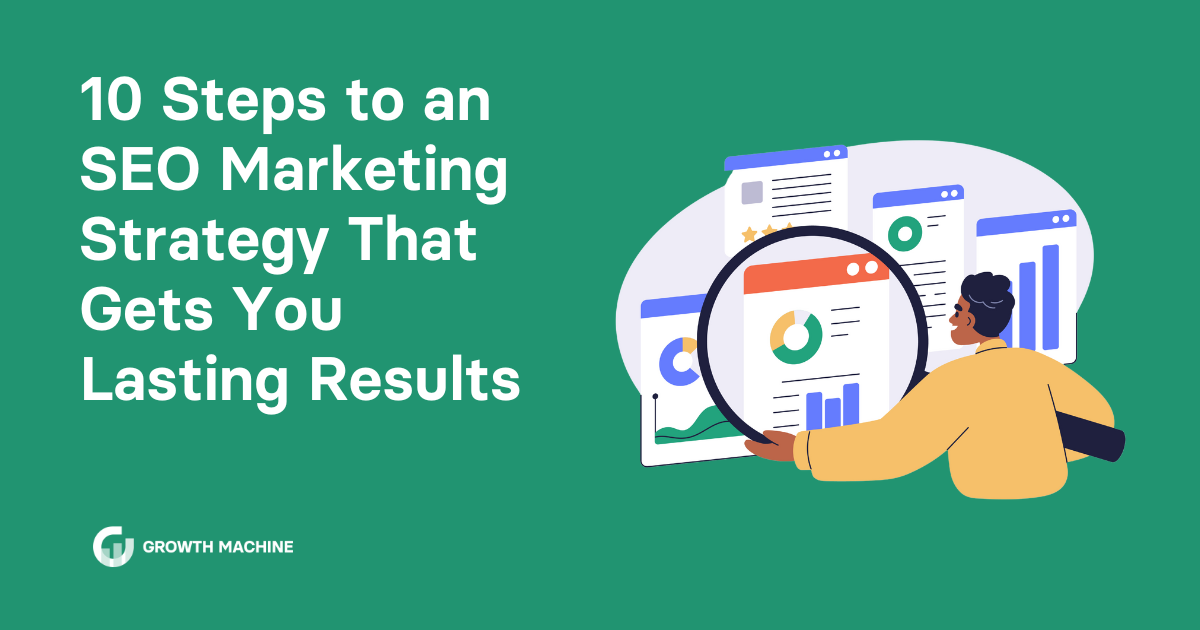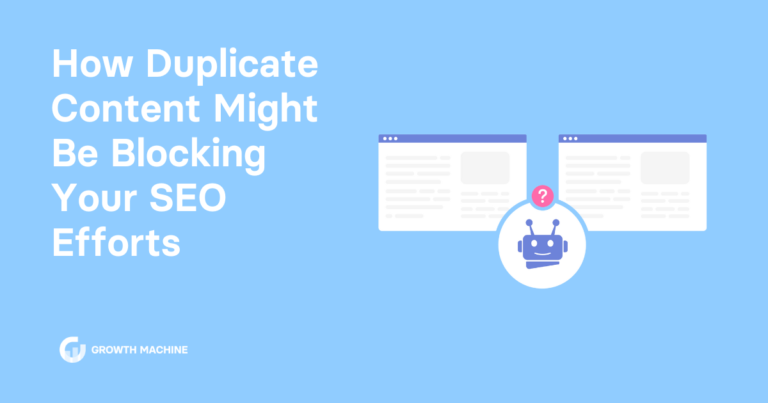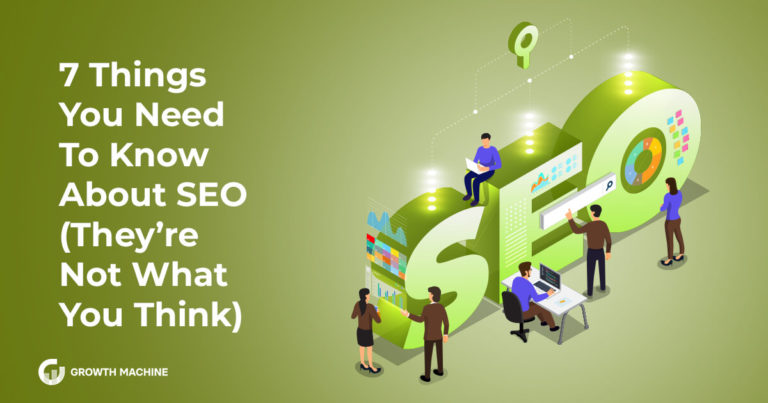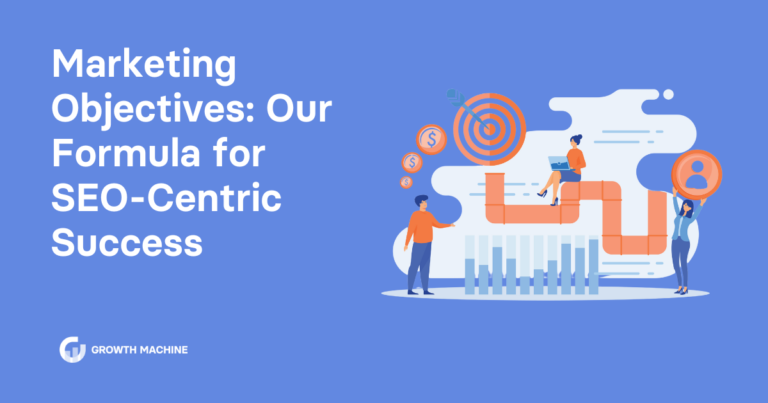10 Steps to an SEO Marketing Strategy That Gets You Lasting Results
Imagine your brand as a beacon of shining light in the digital marketplace.
To ensure that you’re seen by the right audience, you need more than just luck; you need a masterful SEO marketing strategy.
This isn’t just about ticking boxes and putting out anything as content. It’s about seamlessly integrating SEO into your broader marketing efforts to fuel your long-term growth, amplify your brand presence, and skyrocket ROI across all digital marketing channels.
Let’s check out the different ways that effective SEO can act as your brand’s secret weapon in an ever-changing online landscape.
What Is an SEO Marketing Strategy?
An SEO strategy (short for search engine optimization) is your blueprint for digital success.
It’s designed to boost your website’s visibility on search engine results pages (SERPs), draw in more organic traffic, and enhance interactions with your visitors.
A comprehensive SEO strategy covers several key areas:
- Technical site improvements: Fine-tuning your website’s technical framework to ensure it’s both accessible to users and search engine crawlers.
- On-page optimization: Enhancing specific elements on your pages, such as title tags, headings, and meta descriptions, to improve search engine rankings and attract more relevant traffic.
- Strategic content creation: Crafting content that addresses your target audience’s search queries and incorporates targeted, valuable keywords to engage readers and support SEO goals.
- Robust link-building efforts: Securing high-quality backlinks to elevate your site’s authority and improve its position in search results.
Bear in mind the ultimate goal of SEO is to develop a website that not only performs well in Google’s rankings but also engages and delivers genuine value to your audience. By focusing on these core areas, you ensure that your SEO efforts not only boost short-term visibility but also build lasting relationships with your visitors, turning them into loyal customers and brand advocates.
SEO vs. Content Strategy
Often used interchangeably, SEO strategy and content strategy aren’t the same. However, they do work hand in hand.
An SEO strategy enhances your website’s visibility and user engagement through various technical tweaks, content optimizations, and link-building activities.
On the other hand, a content strategy focuses on planning, creating, managing, and distributing content to meet specific business and marketing objectives.
While SEO ensures that the content reaches its intended audience by meeting search engine standards, a purposeful content strategy centers on producing high-quality content that truly resonates and provides value to your audience.
Why Your SEO Strategy Matters
SEO isn’t just another marketing tactic; it’s a necessary part of your strategy that ensures your business isn’t just participating online — it’s leading the conversation.
Here’s how a robust SEO marketing strategy can help you stand out.
Boost Organic Website Traffic
Search rankings and organic traffic are intrinsically linked. Securing a position on the first page of Google not only increases your visibility but significantly boosts your site’s organic traffic.
This is evident in the fact that the #1 result in Google’s organic search results has an average click-through rate (CTR) of 27.6%.
Most users rarely venture past the first page, emphasizing the importance of optimized content and strategic SEO practices to keep your site competitive. By prioritizing SEO strategies that target high rankings, you can dramatically increase organic traffic, enhancing your overall digital marketing efforts.
Outperform Local Competitors
By refining your SEO plan, you can ensure that your business dominates local searches. After all, when your ideal customer is searching for terms related to your business, you want it to be your name they see first.
To achieve this, optimize for region-specific keywords and create content that resonates with your local population. This helps your site stand out as a local authority, increasing visibility and driving more regional traffic.
Maximize Limited Budget
Unlike traditional paid advertising, SEO is actually quite cost-effective — that is, if you’re playing the game right.
SEO can help build a sustainable online presence that delivers compounding returns over time. This makes it essential for businesses looking to make the most of their valuable marketing dollars.
10 Components of a Winning SEO Marketing Strategy
To stay competitive and visible in today’s bustling digital space, a well-rounded and dynamic SEO strategy is crucial.
Your strategy should not only strive to enhance your SERP rankings, but also align with your overarching business goals, giving your brand a solid push towards greater engagement and profitability.
Here’s how you can apply top SEO tactics to stand out and get seen online in 2024.
1. Start with a Comprehensive SEO Audit
A thorough content and technical SEO audit is essential for laying the groundwork for any effective SEO strategy.
This audit allows you to assess the current state of your website’s content, identifying strengths, weaknesses, and opportunities for optimization. It also involves a deep dive into technical SEO elements, such as site architecture, URL structure, mobile-friendliness, and page speed.
An SEO check can also help identify and resolve elements like broken links, improper redirects, and duplicate content, which can hinder your search rankings.
By evaluating both content relevance and technical health, you can pinpoint areas that need improvement and discover new opportunities for keyword targeting and overall performance enhancement.
At Growth Machine, our team meticulously analyzes our clients’ existing content and technical SEO to uncover opportunities for optimization. Learn more about our content services.
2. Set Clear SEO Goals
Implementing an SEO marketing strategy without clear goals is like embarking on a road trip without a GPS or a map. If you don’t have an understanding of where you’re going and how to get there, you’ll end up burning a whole lot of time — and gas — without ever reaching your final destination.
To avoid wasting your team’s precious time and resources, you need to set clear and effective SEO goals.
Get specific with it. Are you aiming to increase organic traffic by a certain percentage? Improve conversion rates from your landing pages? Rank in the top three for specific keywords? Getting clear on your targets will guide your SEO initiatives and provide a clear metric against which to measure your progress.
3. Conduct Strategic Keyword Research
Keyword research is the cornerstone of a successful SEO marketing strategy. It serves as an ear to the ground that can help you better anticipate searchers’ needs.
Research tools like Google’s Keyword Planner and Ahrefs are great starting points to identify relevant keywords used by potential customers.
Targeting long-tail keywords helps you stand out in the crowded digital landscape and attracts targeted traffic to your site that’s more likely to convert. But what separates good SEO from truly great SEO is understanding the search intent behind those keywords.
Are your users looking to buy, learn, or locate something specific? By categorizing keywords based on intent (informational, navigational, transactional, or commercial investigation), you can craft content that aligns with user needs at various stages of their journey.
This not only helps attract more traffic, but the right traffic that is more likely to engage and convert, thus enhancing the effectiveness of your SEO efforts and improving overall user satisfaction.
4. Set Targets and Timelines for Content Planning
Once you’ve identified your target keywords, it’s time to map out a clear plan of how they’ll be deployed strategically in your content.
Set clear targets and timelines for content creation and publication to execute your SEO strategy with precision and align with key business cycles.
For example, we conduct SEO content planning every 2 months with our clients, mapping out a detailed content plan that aligns with their vision and maximizes their marketing efforts.
With a bit of planning, you can maintain a steady, fresh flow of content that boosts SEO and keeps your audience engaged.
5. Prioritize Content Quality Above All Else
You can’t discuss SEO strategy without touching on content. High-quality content is the backbone of successful search engine optimization, regardless of your business size or industry.
As your team brainstorms content ideas, focus on creating engaging content that provides real value to your audience. Make sure you cover the topic in-depth, offering unique insights or perspectives to set you apart from competitors.
Moreover, crafting content that is enjoyable and easy to read can significantly enhance user engagement. A clear and engaging reading style will continue to attract and retain readers, solidifying their loyalty and trust in your brand and increasing the likelihood of conversion.
It’s not all about new content either. Keeping your content high-quality means updating older posts regularly to keep them fresh and relevant. This will boost SEO performance and keep your audience eagerly awaiting your next content drop.
6. Optimize Technical SEO Elements
Think of technical SEO as the bridge between search engines and your web pages. By optimizing everything from the structure of your site to its performance on mobile devices, you ensure your content is discoverable in organic search.
SEO tools like Google’s PageSpeed Insights are indispensable for identifying opportunities to enhance your website’s performance. This thorough optimization ensures your site is not only user-friendly but also fine-tuned for search engine visibility.
Implementing structured data, or schema markup, is another important component of an SEO plan. It helps search engines understand the context of your content better and enables the creation of rich snippets — small previews of your content that appear directly in search results. These snippets offer potential visitors a quick glimpse of what to expect, improving click-through-rates and driving more organic traffic to your site.
7. Integrate Your Strategy Across Channels
Maximize your ROI by ensuring your content marketing strategy transcends a single channel.
For instance, you can integrate your SEO efforts across your brand’s social media channels and email marketing campaigns, in addition to your website. Repurpose high-performing pieces of content into Instagram posts, an email campaign, or into PPC ads to nurture potential customers into making a purchase.
By integrating your SEO approach across these channels, you amplify your reach and strengthen your brand’s voice across all platforms.
8. Earn Purposeful Backlinks
The quality and quantity of backlinks pointing to your website significantly influence your SEO success.
When done well, white hat link-building can enhance your site’s authority and credibility, thereby improving your SERP standing.
Aim to earn backlinks from reputable sites within your industry by sharing content that tackles popular topics with a fresh perspective. You can also earn this by performing outreach, participating in community discussions or collaborating with others in your industry.
9. Keep User Experience Top of Mind
A seamless user experience enhances accessibility, making your site welcoming to a broader audience and ensuring every interaction results in a meaningful connection with your brand.
Given that over 60% of website traffic in 2024 is generated via mobile devices, a mobile-optimized website is a must. Plus, Google’s mobile-first indexing means mobile optimization should be a critical piece of your SEO strategy.
Check that your website is responsive, loads quickly, and displays correctly across all devices. This not only keeps users engaged but also reduces bounce rates, which can positively influence your SEO results.
10. Measure Progress Using Analytics
The top SEO marketers know that strong SEO is all about continuous improvement.
Tools like Google Analytics and Google Search Console are your best friends when it comes to tracking the effectiveness of your SEO strategy.
Pay attention to metrics like traffic sources/patterns, keyword rankings, and user engagement. This will help you understand what’s working and where adjustments might be needed.
Ready to Create a Winning SEO Marketing Strategy?
We get it — navigating search algorithms and SEO can feel daunting. But with the right partner, it doesn’t have to be.
For small businesses especially, an adaptable SEO strategy is crucial. It should evolve alongside your business, seamlessly accommodating new products, services, and markets without requiring a complete redesign. This proactive approach not only conserves resources but also ensures that your SEO efforts continually align with your growing business needs.
At Growth Machine, we specialize in crafting tailored SEO marketing strategies for large or small businesses. Our team of SEO experts is dedicated to enhancing your digital footprint, helping you navigate the complexities of SEO with ease and confidence. Contact us today and let’s amplify your online presence with an impactful SEO strategy.







